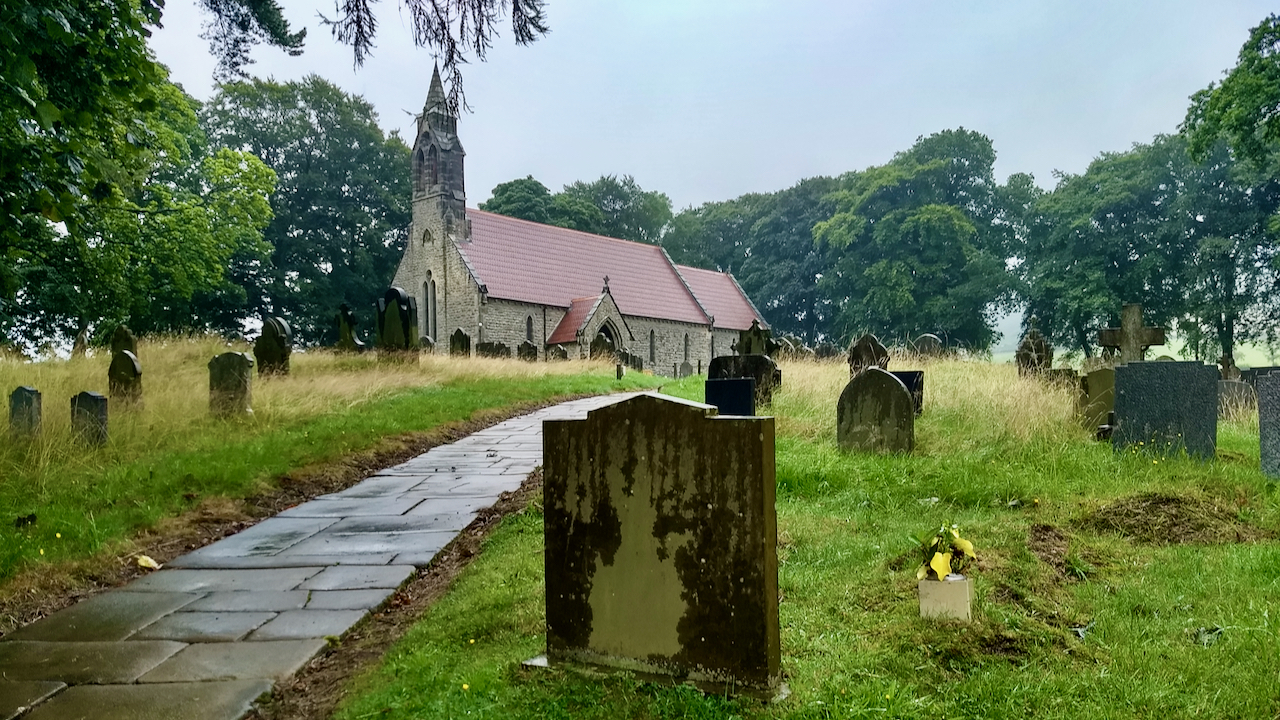A wet miserable day so I’ve had to resort to architectural interest. This is St. Hilda’s Church, Bilsdale, built in the mid-19th-century replacing an earlier 12th-century one. I didn’t look but there is a stone above the porch doorway, which reads:
“COONDDIT ECLEE SIAAM WIILLELMVVS NOBLIS ISTAA OO INTEMERRATE NOOMMIINNE SCE VIIRGINNIIS HILDE”
This evidently translates as “Lord William builds this church in honour of the chaste virgin St Hilda“1Bilsdale.org.uk. (2021). St Hilda, Bilsdale Priory. [online] Available at: http://www.bilsdale.org.uk/index.php?id=15 [Accessed 21 Aug. 2021].. William was the father (or uncle) of Walter Espec who, in 1122, founded Kirkham Priory and, in 1132, Rievaulx Abbey. This follows from yesterday’s post.
The church is known as Bilsdale Priory but as far as I can tell there has not been a priory in Bilsdale. The name probably stems from its central location in this estate of Kirkham Priory land.
I realised today how little I know of monastic orders. I hadn’t appreciated the difference between an Augustinian and a Cistercian monk. So I’ve had a bit of a delve.
In mid-12th-century North Yorkshire, there were over fifty monastic houses of varying sizes and orders. Abbeys, priories, nunneries, cells.
To try to make sense of the confusion, I’ve tabulated the differences which I usually find helps:
| Benedictine | The old hands at the monastic life. Been around since Anglo-Saxon times. Lived communally, following a strict liturgical routine. Maintained by grants from landed estates who benefited from their prayers. | Whitby Abbey, later Lastingham. Nunnery at Arden. Cell at Goathland. |
| Cistercian | The “White monks”. Isolated communities in receipt of land grants enabling a land based economy predominately in wool and (in the case of Rievaulx) iron ore smelting. Many remote granges worked by lay brothers. The ideal would be not to have contact with any sitting tenants. | Abbeys at Rievaulx/Byland/Fountains/Jervaulx. Nunneries at Baysdale/Rosedale/Handale/Wykeham. |
| Augustinian | Lived a semi-monastic life of contemplation and apostolic ministry, committed to the pastoral care of the locality by frequently providing the parish clergy. Houses less expensive to establish. | Priories at Guisborough and Healaugh Park. Chapelry at Kildale. |
| Grandmontine | The life was eremitical and very severe in regard to silence, diet and bodily austerities | Grosmont |
| Carthusian | A very eremitical community (hermit and reclusive) emphasising individual solitude. | Mount Grace Priory |
| Carmelite | The “White Friars”. Originally led an eremitic way of life, but changed to a mendicant (begging) by Papal ‘order’ in 1215. | Kildale2Burton, Janet. “6.7 Religious Houses”. “Historical Atlas of North Yorkshire.” Edited by Robin A Butlin. p. 90 Westbury Publishing. Reprinted 2004. ISBN 1 84103 023 6 |
| Crutched Friars | Emphasis on poverty, begging, and preaching. | Oratory at Kildale later Blakey Ridge, house at York. |
| Knights Templars | A Cistercian, military order associated with the protection of pilgrims to the Holy Land and later the Crusades. | Preceptory at Westerdale. |
| Dominican | The “Black Friars”. Emphasised poverty, and preaching. As official Inquisitors, they had papal authority to use torture to extract confessions. They were involved in anti-heretical activities from the beginning simply by preaching and acting as living examples of the Gospel life. | Friary at York, Yarm priory. |
| Franciscan | The “Grey Friars”. Very similar to the Dominicans and were also approved to act as Inquisitors. | Friary at York |
| Austin | An Augustinian life of poverty and preaching. | Friary at York |
| Friars of the Sack (Brothers of Penitence) | Proverty/begging/preaching. Augustinian but with simple clothing, usually made from sackcloth | Friary at York |
| Gilbertine | A mixed house (monks and nuns) of poverty and preaching. | Friary at York, priory at Old Malton. |
| Premonstratensian | The “White Canons”. Characterised by a ritual solemnity. | Easby Abbey |
- 1Bilsdale.org.uk. (2021). St Hilda, Bilsdale Priory. [online] Available at: http://www.bilsdale.org.uk/index.php?id=15 [Accessed 21 Aug. 2021].
- 2Burton, Janet. “6.7 Religious Houses”. “Historical Atlas of North Yorkshire.” Edited by Robin A Butlin. p. 90 Westbury Publishing. Reprinted 2004. ISBN 1 84103 023 6

Leave a Reply